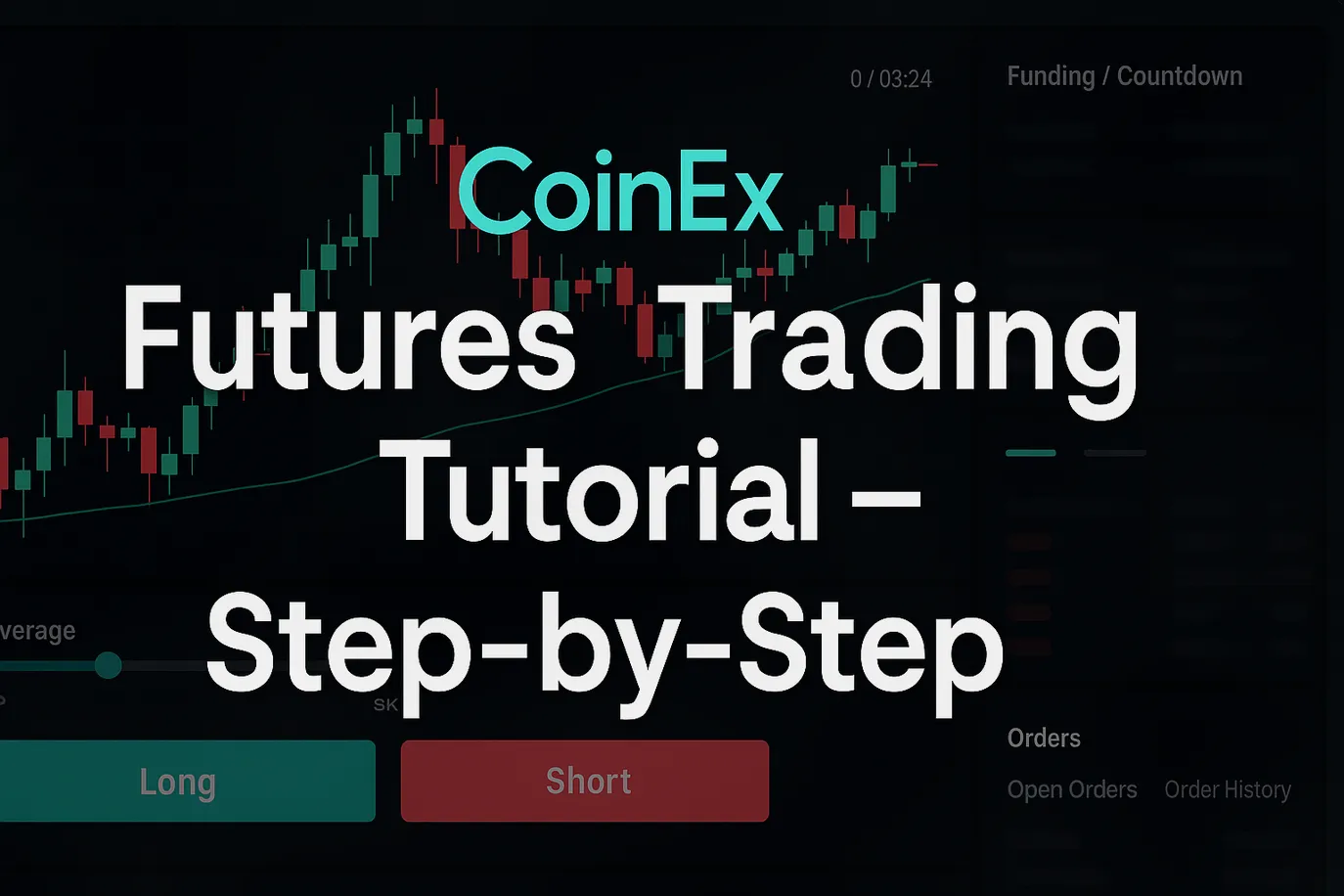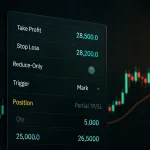Whether you want to hedge, speculate, or build a disciplined system, this CoinEx Futures Trading Tutorial walks you through the entire flow—from account setup to risk controls and advanced order logic—so you can operate confidently on CoinEx futures.
Before we begin: trading futures involves substantial risk, including the possibility of losing more than your initial margin. This guide is educational only and not financial advice. Always trade within your risk tolerance.
- Quick start sign-up: use the official referral link Join CoinEx with code mhz7w and enter code mhz7w during registration.
What this CoinEx Futures Trading Tutorial will cover
- Account setup and security hardening
- Funding your futures account and transferring margin
- Understanding perpetual contracts, leverage, margin modes, and funding
- Navigating the CoinEx futures interface like a pro
- Placing limit, market, and trigger orders with TP/SL
- Using reduce-only, post-only, and time-in-force
- Managing risk with sizing, stops, and daily loss limits
- A step-by-step trade walkthrough
- Common pitfalls and how to avoid them
- Optional automation, alerts, and API keys
If you’re new to CoinEx, register here: Sign up for CoinEx with referral code mhz7w. You may be eligible for ongoing exchange promotions subject to CoinEx’s terms.
Getting started fast
1) Create your account
– Visit CoinEx registration and complete sign-up. Use code mhz7w if prompted.
– Verify email and set a strong password.
2) Secure the account
– Enable 2FA (authenticator app recommended over SMS).
– Set an anti-phishing code so official CoinEx emails are clearly identifiable.
– Consider withdrawal address whitelisting and withdrawal time-locks.
3) Add funds
– Deposit crypto from your wallet or buy via available on-ramps inside CoinEx.
– Transfer funds from your Spot account to your Futures account in the Assets panel. This transfer is off-chain and instant inside CoinEx.
4) Understand risk limits
– CoinEx uses risk tiers that adjust max position size and maintenance margin as your positions scale. Larger notional exposure increases maintenance margin. Use the on-screen risk indicator before committing size.
CoinEx futures essentials
- Perpetual contracts: These track an underlying index and do not expire. CoinEx offers USDT-margined perpetuals and may offer coin-margined markets on certain assets. Settlement and margin currency depend on the contract type.
- Leverage: Select a leverage level appropriate to your strategy. Leverage limits vary by market and risk tier; conservative traders often use 2–5x until they master execution.
- Mark price: Liquidation and PnL reference the mark price, not the last traded price, to limit manipulation. Keep an eye on the mark price displayed in the trading panel.
- Funding rate: Longs and shorts pay each other periodically to anchor the contract to spot. When funding is positive, longs pay shorts; when negative, shorts pay longs. Timers show the countdown to the next funding event.
- Fees: Maker orders (adding liquidity) typically incur lower fees than taker orders (removing liquidity). Check the Fee Schedule inside CoinEx for exact maker/taker percentages and any VIP discounts.
Interface tour you’ll actually use
- Market selector: Choose the futures pair (e.g., BTCUSDT Perpetual). Confirm margin currency and leverage limits.
- Price chart: Candlestick view with indicators. You can place orders from the panel beside or below the chart.
- Order panel: Select margin mode (Isolated/Cross), set leverage, choose order type (Limit, Market, Trigger), define price, size, and TP/SL.
- Order book and trades: View live bids/asks and recent prints. Depth matters when sizing market orders.
- Positions and orders: Monitor open positions, entry price, mark price, unrealized PnL, margin, liquidation estimate, and set TP/SL or close quickly.
- Funding and risk: See the funding rate and countdown, plus ADL (auto-deleveraging) indicators during high volatility.
- Calculator: Use it for PnL, target price, and liquidation estimates before you place a trade.
Margin modes and leverage made simple
- Isolated margin: Margin is confined to that single position. If it’s liquidated, other balances aren’t automatically used. Good for testing strategies or containing risk on one idea.
- Cross margin: Uses your entire futures balance to support open positions. This can reduce the chance of liquidation on a single position but can also expose more of your account to a cascading loss if risk is mismanaged.
Guidelines
– Start with isolated margin, modest leverage (2–5x), and a small position size.
– Switch to cross only when you fully understand the implications and have strict daily loss limits.
Liquidation basics
– Liquidation price depends on your entry, leverage, fee rate, and maintenance margin tier. The on-platform calculator is the source of truth. Keep a buffer by using lower leverage and placing a protective stop.
Order types you will use most
- Limit: You set the price and size. Add “Post Only” to ensure maker execution or the order will cancel if it would match as taker.
- Market: Executes immediately at the best available price. Watch slippage—especially on thin books.
- Trigger (Stop): A condition that, when met, places a limit or market order. Use this for stop-loss and breakout entries.
- TP/SL: You can attach take-profit and stop-loss to new or existing positions. The “Reduce Only” option ensures your exits won’t accidentally increase position size.
- Time-in-Force: GTC (good till canceled), IOC (immediate or cancel), and FOK (fill or kill) give you precise control over order behavior.
Pro setup
– Bracket your trade with both TP and SL as soon as you open the position. Reduces reaction time and mistake risk.
Risk management that keeps you in the game
- Risk per trade: Many pros risk 0.25%–1% of account equity per idea. Calculate backward from your stop distance to determine size.
- Daily loss limit: Cap total daily drawdown (e.g., 2–3%). Stop trading after hitting it; discipline beats revenge trades.
- Volatility filter: Use ATR or recent range to avoid sizing too large in fast markets.
- Funding awareness: Large positions around funding times can impact PnL. If you’re on the paying side, consider whether to reduce or hedge.
- Correlation: Avoid stacking multiple positions that move together; it compounds risk more than you expect.
Simple sizing example
– Account equity: 1,000 USDT
– Risk per trade: 0.5% = 5 USDT
– Planned stop: 1% below entry on a 5x long means the leveraged move hits quickly. To limit loss to 5 USDT, size so a 1% adverse move equals 5 USDT loss on notional. Use the in-panel calculator for accuracy.
Step-by-step trade walkthrough
Scenario: You want to long ETHUSDT Perpetual after a pullback to support.
1) Choose market and mode
– Select ETHUSDT Perpetual.
– Set Isolated margin and 3–5x leverage.
2) Define the plan
– Entry: 3,000 (example)
– Stop: 2,940 (2% risk window)
– Take-profit: 3,120 (4% above entry) for a 1:2 risk-reward.
3) Calculate size
– Risk budget: 0.5% of equity
– Use the calculator so that a 2% move from entry to stop equals your risk budget.
4) Place the entry
– Limit Buy at 3,000 with Post Only if you prefer maker fees.
– Toggle Reduce Only on exits, not on entries.
5) Attach TP/SL
– Take-profit limit at 3,120.
– Stop-loss trigger at 2,940, choose market execution for certainty.
6) Monitor
– Watch mark price, not just last traded price.
– Note the funding countdown; if you’ll pay funding soon and are near TP, consider partial scaling.
7) Manage
– If price moves favorably, consider moving stop to breakeven after a strong impulse and acceptance above your entry.
– Use partial close to lock in profits without over-tightening the stop too early.
8) Exit
– Let your TP/SL execute. Avoid overmanaging unless the market thesis changes.
Fees, funding, and PnL hygiene
- Maker vs taker: Market orders are convenient but can cost more. If the setup allows, use limits with Post Only to target maker rebates/discounts.
- Funding payments: Charged or credited periodically. Your net PnL includes funding; don’t ignore it on multi-day holds.
- Hidden costs: Slippage and spread are real costs. Backtest strategies using realistic spread and slippage assumptions.
Common mistakes to avoid
- Oversizing with high leverage. Small mistakes become large quickly.
- Ignoring mark price. Your liquidation depends on it.
- Forgetting Reduce Only on exits. Without it, a TP limit could flip you if it triggers while flat.
- Leaving stops as limit orders during fast moves. Stop-market is often safer for protection.
- Trading illiquid alt perpetuals with market orders. The book can be thin.
- Switching margin modes mid-position without understanding the effect on liquidation.
Advanced tools and automation
- Conditional orders: Build layered entries and exits to scale in/out.
- Alerts: Use chart alerts and mobile push notifications to react on time.
- API access: Create API keys for automated strategies. Restrict permissions, whitelist IPs, and store keys securely. Rotate keys periodically.
- Journaling: Track setups, sizes, entry rationales, and emotional state. A simple spreadsheet with screenshots improves consistency.
FAQ for this CoinEx Futures Trading Tutorial
-
Does CoinEx offer both USDT- and coin-margined contracts?
Availability varies by asset; check the market selector and contract specs. -
How high is the maximum leverage?
It depends on the market and your risk tier. Conservative leverage is usually safer for most traders. -
What’s the difference between order price and mark price?
Mark price is derived to reduce manipulation and is used for liquidation and PnL calculations. -
Can I hedge on CoinEx?
You can run long and short on different contracts or switch to a hedge mode when available per instrument rules. Review the position mode settings. -
Are there demo accounts?
If a demo mode isn’t available, start with very small size and isolated margin to simulate learning conditions.
Ready to practice
- Create your account: Register on CoinEx
- Referral code: mhz7w
- Start small, use isolated margin, pre-attach TP/SL, and let your edge come from process—not prediction.
This entire CoinEx Futures Trading Tutorial is designed to be actionable. Save it, adapt it to your workflow, and refine incrementally as you gather real data from your trades.
Disclosures: This is educational material, not investment advice. Futures trading is risky. Review CoinEx’s official documentation, fee schedule, and contract specifications before placing live trades.





